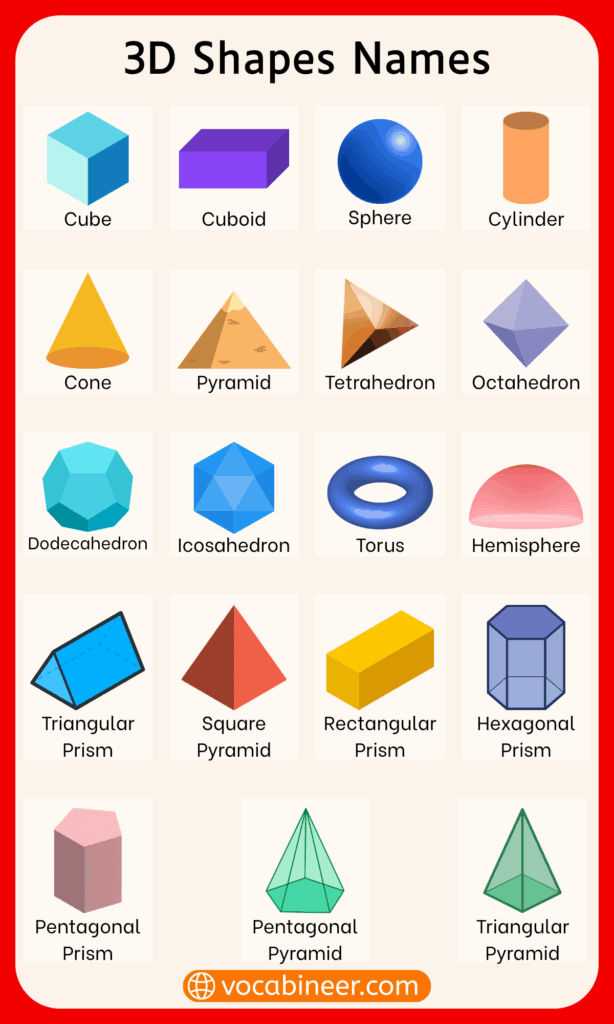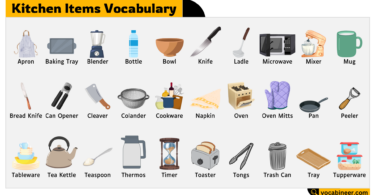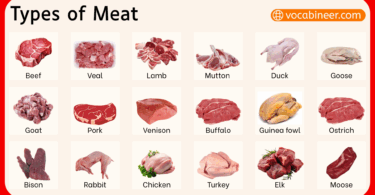Learning 3D shapes names in English builds strong vocabulary for describing everyday objects. These shape words like cube, cylinder, and sphere—help students and ESL learners talk clearly in both class and daily life. This list uses pictures and example sentences to make each shape easier to remember. Whether you’re studying geometry or teaching kids, this picture-based guide will help you learn each 3D shape name with usage.
In This Page
Common 3D Shapes with English Names
These are the most widely used 3D shapes in English classrooms and everyday conversation:
- Cube – A cube has six equal square faces.
Example: The gift box is shaped like a cube. - Cuboid – A cuboid looks like a rectangular box.
Example: The fridge is a cuboid with straight edges. - Cylinder – A cylinder has two flat circular faces and one curved surface.
Example: We stored pencils in a cylinder-shaped container. - Sphere – A sphere is perfectly round with no edges or corners.
Example: A football is a good example of a sphere. - Cone – A cone has a round base and a pointed top.
Example: The ice cream cone has a cone shape. - Pyramid – A pyramid has a polygon base and triangle faces meeting at a point.
Example: The monument was shaped like a pyramid. - Prism – A prism has two identical polygon bases and flat sides.
Example: A glass prism reflects sunlight into colors.

Complete List of 3D Shapes with Example Sentences
This section expands the vocabulary with more solid shapes and how to use them in context:
- Cube
The dice is shaped like a cube. - Cuboid
He packed the books in a cuboid box. - Cylinder
The candle is a cylinder with flat circular ends. - Sphere
She bounced a sphere across the room. - Cone
He bought an ice cream in a cone. - Pyramid
We saw a model of a pyramid in the classroom. - Triangular Prism
The tent looked like a triangular prism. - Rectangular Prism
The refrigerator is a rectangular prism. - Pentagonal Prism
He built a pentagonal prism with cardboard. - Hexagonal Prism
The toy block was a hexagonal prism. - Torus
A doughnut has the shape of a torus. - Hemisphere
The bowl is shaped like a hemisphere. - Octahedron
The crystal was cut like an octahedron. - Dodecahedron
The math teacher showed a dodecahedron model. - Triangular Pyramid
She folded a paper into a triangular pyramid. - Square Pyramid
The cap of the tower was a square pyramid. - Ellipsoid
An egg is shaped like an ellipsoid. - Oblate Sphere
The Earth is an oblate sphere, not a perfect ball. - Frustum
The vase was shaped like a frustum.
Vocabulary of Round and Curved 3D Shapes
This group includes shapes with curved surfaces, useful in science and real-world objects:
- Cylinder – Found in cans, pipes, batteries
Example: The soda can is a cylinder. - Sphere – Seen in sports balls and bubbles
Example: The marble is a shiny sphere. - Cone – Seen in party hats and traffic cones
Example: The orange sign was a cone to warn drivers. - Torus – Circular and hollow
Example: The ring-shaped candy looked like a torus. - Hemisphere – Often used in geography or kitchen bowls
Example: The dome is shaped like a hemisphere.
Names of 3D Shapes Faces, Edges, and Vertices
Knowing the parts of 3D shapes helps you describe their shapes more clearly. It makes it easier to talk about objects and understand how they are built.
Cube
- Faces: 6 (squares)
- Edges: 12
- Vertices: 8
Cuboid
- Faces: 6 (rectangles)
- Edges: 12
- Vertices: 8
Sphere
- Faces: 1 (curved surface)
- Edges: 0
- Vertices: 0
Cylinder
- Faces: 3 (2 circular + 1 curved)
- Edges: 2
- Vertices: 0
Cone
- Faces: 2 (1 circular + 1 curved)
- Edges: 1
- Vertices: 1
Square Pyramid
- Faces: 5 (1 square + 4 triangles)
- Edges: 8
- Vertices: 5
Triangular Prism
- Faces: 5 (2 triangles + 3 rectangles)
- Edges: 9
- Vertices: 6
Everyday Use of 3D Shapes in English
Real-life objects help learners remember 3D shape vocabulary better:
- A cube can be a dice or Rubik’s cube.
- A cylinder can be a can, bottle, or pipe.
- A sphere can be a globe or orange.
- A cone is used in ice cream, party hats, or signs.
- A pyramid is seen in architecture or games.
- A torus appears in lifebuoys or rings.
- A hemisphere is used in earth models and lamps.
Example: I rolled the sphere across the floor to my friend.
Picture-Based 3D Shapes List for ESL Learners
This section is great for beginners and visual learners:
- Cube – Box shape
- Cuboid – Brick shape
- Cylinder – Tube shape
- Sphere – Ball shape
- Cone – Funnel shape
- Pyramid – Triangle sides
- Torus – Ring shape
- Hemisphere – Half ball
- Prism – Long flat faces
Use flashcards, shape toys, or real-world items to connect names with objects.
What’s the Difference Between 2D and 3D Shapes?
2D shapes are flat with only height and width, while 3D shapes are solid and have depth too. The table below highlights their main differences.
| Feature | 2D Shapes | 3D Shapes |
|---|---|---|
| Dimension | Length and width | Length, width, and height (depth) |
| Shape Type | Flat | Solid |
| Surface | No thickness | Has volume and surface area |
| Edges | Only sides | Edges, faces, and vertices |
| Drawn On | Flat surface (paper, screen) | Exists in space (can be held) |
| Examples | Circle, Square, Triangle | Sphere, Cube, Cone, Cylinder |
FAQs
The 10 main 3D shapes in English are Cube, Cuboid, Sphere, Cylinder, Cone, Pyramid, Prism, Triangular Prism, Rectangular Prism and Torus.
The sphere is fully curved with no edges.
Use picture cards, real-life examples, and sentence practice like “This ball is a sphere.”
3D shapes have depth and volume; 2D shapes are flat with only height and width.
They help describe objects clearly in conversation, science, and education.
Read More




